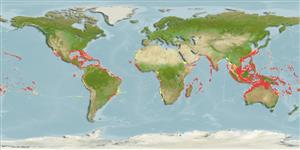กลุ่มปลาที่มีครีบคู่ แผ่แบนออกได้ลักษณะคล้ายพัด >
Perciformes (Perch-likes) >
Carangidae (Jacks and pompanos) > Caranginae
Etymology: Caranx: French, carangue, the name of a Caribbean fish; 1836 (Ref. 45335). More on author: Poey.
ภาวะแวดล้อม / สภาพภูมิอากาศ / พิสัย
นิเวศวิทยา
; เกี่ยวกับทะเล,น้ำเค็ม กลุ่มสัตว์หน้าดิน,กลุ่มสัตว์พื้นท้องน้ำ; สัตว์น้ำที่อาศัยและอพยพภายในทะเลเท่านั้น (Ref. 51243); ระดับความลึก 12 - 354 m (Ref. 9710), usually 24 - 65 m (Ref. 5217). Subtropical, preferred ?; 30°N - 30°S, 180°W - 180°E
Circumtropical. Western Indian Ocean: off Natal and East London in South Africa (Ref. 3197, 11228); Reunion, Mauritius and Cargados Carajos (Ref. 33390); Seychelles (Ref. 10685). Western Pacific: southern Japan to New Caledonia. Recently reported from Tonga (Ref. 53797). Western Atlantic: Bermuda and the northern Gulf of Mexico to Brazil. Eastern Atlantic: Azores, Madeira, St. Paul's Rocks (Ref. 13121), Ascension Island, Cape Verde, and Gulf of Guinea. Eastern Central Pacific: Mexico (including Revillagigedo Islands) to Costa Rica.
Length at first maturity / ขนาด / น้ำหนัก / Age
Maturity: Lm ?, range 38 - ? cm
Max length : 100.0 cm TL เพศผู้/กระเทย; (Ref. 7251); common length : 70.0 cm TL เพศผู้/กระเทย; (Ref. 5217); น้ำหนักสูงสุดที่มีการรายงาน: 17.9 kg (Ref. 40637)
เงี่ยงครีบหลัง (รวม): 9; ก้านครีบอ่อนที่หาง (รวม): 20-22; เงี่ยงครีบก้น 3; ก้านครีบอ่อนที่ก้น: 16 - 19.
An oceanic and insular species, very much restricted to clear oceanic waters (Ref. 9283). Not commonly found in shallow banks (Ref. 9283). Sometimes seen near drop-off at outer edge of reefs (Ref. 26938). Occasionally forming schools. Feed on fishes at night (Ref. 5213). Eggs are pelagic (Ref. 4233). Marketed mainly fresh, also dried or salted (Ref. 9283).
Paxton, J.R., D.F. Hoese, G.R. Allen and J.E. Hanley, 1989. Pisces. Petromyzontidae to Carangidae. Zoological Catalogue of Australia, Vol. 7. Australian Government Publishing Service, Canberra, 665 p. (Ref. 7300)
IUCN Red List Status (Ref. 115185)
CITES (Ref. 94142)
Not Evaluated
Threat to humans
Reports of ciguatera poisoning (Ref. 9710)
Human uses
การประมง: มีการค้าเพียงเล็กน้อย; การเพาะเลี้ยงสัตว์น้ำ: การค้า; การตกปลาเป็นกีฬา: ใช่
ข้อมูลเพิ่มเติม
อ้างอิงการเพาะเลี้ยงสัตว์น้ำประวัติการเพาะเลี้ยงสัตว์น้ำสายพันธุ์พันธุศาสตร์ความถี่ของคู่ยีนอัตราพันธุกรรมโรคการแปรรูปMass conversion
เครื่องมือ
Special reports
Download XML
แหล่งที่มาจากอินเตอร์เน็ต
